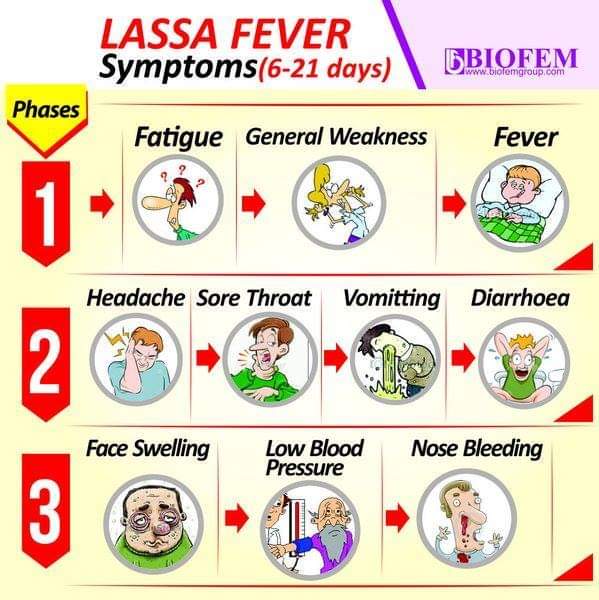WHAT IS THE CAUSE OF LASSA FEVER??
Lassa fever is an acute viral haemorrhagic illness caused by Lassa virus, a member of the arenavirus family of viruses. It is transmitted to humans from contacts with food or household items contaminated with rodent excreta. The disease is endemic in the rodent population in parts of West Africa.
SIGNS AND SYMPTOMS OF LASSA FEVER.
The incubation period of Lassa fever ranges from 6–21 days. The onset of the disease, when it is symptomatic, is usually gradual, starting with fever, general weakness, and malaise. After a few days, headache, sore throat, muscle pain, chest pain, nausea, vomiting, diarrhoea, cough, and abdominal pain may follow.
WHAT ARE THE COMPLICATIONS OF LASSA FEVER??
Neurological problems have also been described, including hearing loss, tremors, and encephalitis. Death may occur within two weeks after symptom onset due to multi-organ failure. The most commoncomplication of Lassa fever is deafness.
IS LASSA FEVER CONTAGIOUS??
Lassa fever is one of the hemorrhagic fever viruses like Ebola virus, Marburg virus, and others. Unlike Ebola virus, Lassa fever is not as contagious person to person, nor as deadly. Lassa virus is typically transmitted by the urine or feces of Mastomys rats to humans.
DO ALL RATS CAUSE LASSA FEVER??
Lassa fever is an acute viral hemorrhagic diseasecaused by the Lassa virus. It can be transmitted to humans via multimammate rats. Most cases occur in rural communities where rat populations are high, and hygiene and sanitation conditions are poor. Lassa fever is endemic to West Africa.
HOW LONG CAN LASSA FEVER LAST OUTSIDE THE BODY AND HOW DO YOU TEST FOR IT??
SURVIVAL OUTSIDE HOST: The virus is stable as an aerosol, particularly at low relative humidity (30 % RH). The biological half-live at both 24°C and 32°C ranges from 10.1 to 54.6 minutes(20). SURVEILLANCE: Definitive diagnosis is reached mainly upon laboratory testing














